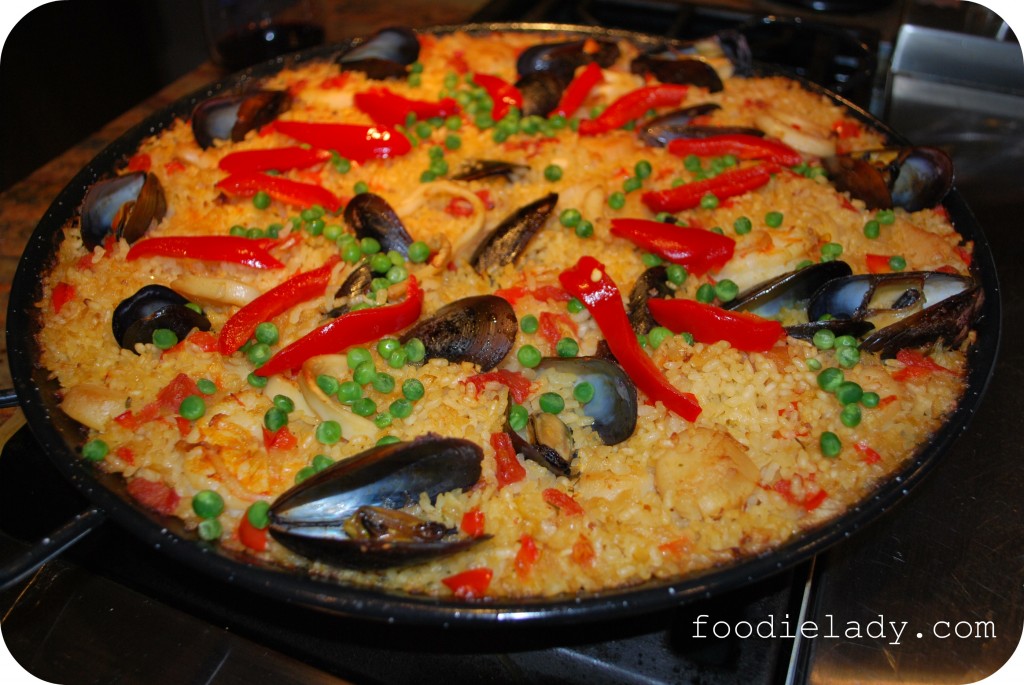
I am enamored with traditional Paella! The first time I actually attempted to make a Paella was in 2000, a couple of years into our marriage (about 11 years ago). We were still childless and had recently moved to a house in a nice neighborhood filled with young couples with little or adolescent children. In efforts for the adults to have fun without having to call for a babysitter and go out, these people liked to have gatherings on the street, as in-front of our homes. It was a lot of fun! Everyone would bring their folding chairs, food and drink.
One day, I remember my husband Emilio arriving home from work and asking me if we had any plans for Día de Reyes (January 6- Epiphany), which is a holiday in Puerto Rico. Unaware of what was coming my way, I said we had no plans, to which he immediately replied “then, we are cooking Paella on the street for 20 + persons”. AHHHHH! But I’ve never cooked Paella!!! to which he responded “well, look for a recipe, because I told everyone you make the best Paella.”
First, we borrowed the equipment (Paellera-Paella Pan and burners) form my mother, then I looked for a simple recipe of Paella Valenciana and improvised. I guess everyone was drunk by the time the “Paella” was ready, since it took a few hours to make between my inexperience in controlling the heat, making the sofrito and the huge amount of rice. I remember I kept adding liquid until the rice was cooked. Not good… To me, it seemed like ages the time it took to be ready, but it wasn’t a total disaster, everybody ate it.
As the years passed, I put my Paella “skills” to rest until recently, when a particular interest in this craft was revived in me as I ordered a Paella last summer in a restaurant in Bimini in the Bahamas (July 2010), of all places. It was succulent! I started reading about how to make this dish to perfection. I interviewed people and reviewed recipes from cookbooks, periodicals and the internet.
I find it amusing how everyone claims to have the secret to the best Paella! (The same goes for brownies!!!) Making Paella is an art and is also very entertaining for your guests. I can assure you they’ll all have an opinion about what you should do next in the preparation process, which is fun too! However, most people have no idea about the origins of Paella and its true main ingredients and technique. Many Paellas sold nowadays in Puerto Rico have little to do with the real thing. They are mostly “arroces a la chorrera”, which means in Cuban slang, “soupy rice”. Don’t get me wrong, they are also delicious, but different. So, you know me, I set out to find out what makes a true Paella!
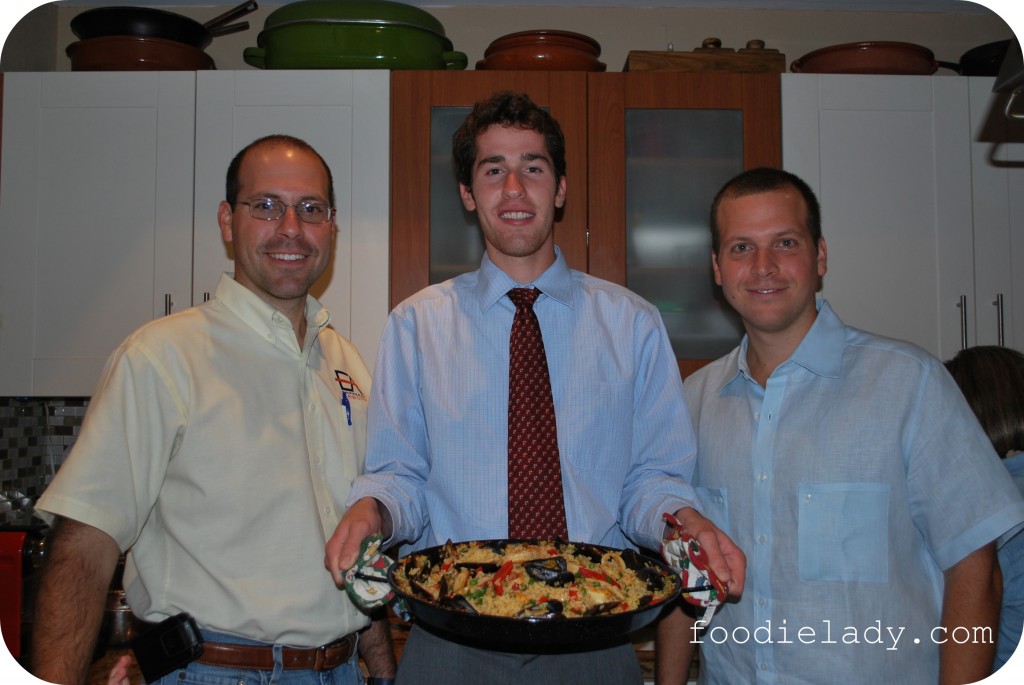
The word Paella means pan in Valencian and Catalan. In Spain, most purists would probably say “arroz en paella“, if its not Valenciana, to what we non-spaniards call Paella as the generic term to the food, not the cooking utensil, which now is widely known in Spanish speaking countries as Paellera (Paella Pan). During the centuries following the introduction of rice in Spain (the Middle Ages-Moor invasion), field workers in the Valencia region cooked the rice in flat round shallow iron pans (later steel) with two looped handles on opposite sides. They would set the Paella over an open fire and add whatever was readily available (or cheap) in the region like snails, green beans, tomatoes, onions, duck and even nutria (river otter) to the rice and liquid. If the family was affluent, they would add chicken to the Paella as well while cooking in outdoor gatherings and picnics. From what I’ve read, the original Paella doesn’t have seafood in it for its roots are in the Spanish prairies of Valencia, but today there are many variations widely accepted and this is my favorite one!
By no means I claim to have mastered the technique, but I believe that following these steps increases your chances of success. It will take practice, trial and error. Here I will share with you the principles of what makes authentic Paella, no matter which ingredients you use to add flavor. Once you understand this technique, don’t be afraid to be creative and make your own version of Paella.
#1 – Rice is the single most important ingredient in a Paella. The rice used should be short and round like Bomba or Calasparra Rice, a rice of Indian origin brought to Spain in the Middle Ages, which you can find at your local specialty food shop or mail order in my Amazon store to the top-right of this page. As a last resort, the widely available medium rice can also be used if you can’t find Bomba Rice. However, long grain or parboiled rice should never be used to make Paella, even though most people would be inclined to use parboiled under the premise that it doesn’t stick or cannot be overcooked, but be mindful it absorbs little flavor. It is important that you recognize that the key to a spectacular paella is the way the rice absorbs the flavors of the ingredients in the sofrito and the liquid. As a result, this can only be achieved with a rice that can absorb double its measurement in liquid, remaining intact and separated without releasing a lot of starch. Bomba rice is excellent for this and it yields a loose grain with amazing texture and flavor when cooked properly. Paella should not be creamy like a Risotto. Finally, Paellas are never cooked covered, it is only at the end of the cooking period without direct heat, called the resting period, that the Paella is coverd with a towel, newspaper or foil paper to retain the remaining moisture and finish cooking.
#2 Paellera (Paella Pan)- A good Paella Pan (Paellera) made of a thin conductive metal like iron or steel, is also essential in creating a perfect Paella. The purpose for this round shallow pan made of steel or enameled steel is to cook the rice evenly in a thin layer. That is why Paelleras grow in diameter, not in height. Valencians say that the layer of rice should be as thick as un ditet (one small finger). The more rice is close to the bottom of the pan, the more tasty it will be, since that’s where flavor is. I admit my Paellas are more like a ditet and a half deep. Nevertheless, another interesting fact is that most Paelleras are dipped a little in the center for the oil to pool during the sauteing of the sofrito (sauté of vegetables, grated tomatoes and aromatics) in the beginning of the cooking process.
#3 Sofrito- This is mainly when you sauté vegetables over medium heat in extra-virgin olive oil like onion, garlic, red bell peppers with grated tomatoes and allow them to soften and the flavors to bloom. It provides the flavor base to the Paella.
#4 Liquid- A flavorful homemade stock will cook the rice and infuse it with gusto. If you don’t have a homemade stock at hand, use a low sodium store bought or improvise at home by bringing to a boil shells of shrimp, water, bouquet garni and salt. Saffron and sweet smoked Spanish paprika (pimentón) are also a must in every paella for color and distinctive flavor. I sometimes make fish stock with the leftover heads of my husband’s catch of the day, if he has gone fishing, and use it for Paella. The most widely used measurement is for every cup of rice/ 2 cups of liquid (give or take a little depending on how much liquid the sofrito yielded).
#5 Heat source- The traditional method is cooking the rice in the paellera over an open fire. However, this is not always available or possible. I start making the paella in my gas stovetop and finish it in the oven by placing it in the lowest rack near the heat and it works great. Nevertheless, little socarrat is made in this method, which doesn’t bother me. Socarrat is considered by many the way to tell if a Paella is done correctly, or the prize for the cook at the end of the process. It is the equivalent of our pegao (stuck to the bottom rice), favored by many for its crunch and flavor. The way to make socarrat is to increase the heat at the end and listen carefuly for the rice to crackle. Immediately turn off heat and cover for the final resting period. Test with a fork, if you find resistance in the bottom OLE!… you have socarrrat, but its not necessary. Other heat sources are a large coal or gas BBQ or a large gas range with legs that is sold for making paellas.
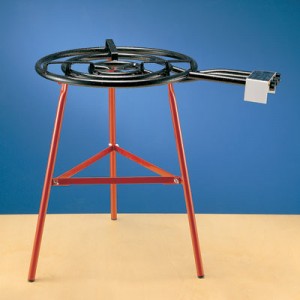
Now, who is afraid of cooking Paella Marinera? Well, I will be hosting my first GIVEAWAY of a 15 inch Paella Pan, a bag of Bomba Rice and Spanish Sweet Smoked Paprika (similar to the ones pictured below), to one lucky reader, anywhere in the world. All you need to do is comment in this post (you don’t have to make the recipe) and a winner will be randomly selected by a computer during the next week. That simple!!!!! My wish is that you fill your minds with courage and your hearts with a foodieventurous spirit and give this recipe a try!

Paella Marinera (Seafood Paella)
Ingredients
3/4 cup of extra-virgin olive oil
10 scallops
10 large shrimp/prawns/langostinos
1 cup of calamari rings
scant 6 cups of fish stock (about 5 cups and a half- 3/4)
1/2 cup white wine
1 pound of mussels
2 generous pinch of saffron threads
1 tsp sweet smoked paprika (Spanish)
1 1/2 tbsp fine sea salt (depends, if your broth is too salty use less sea salt)
3 cups arroz Bomba (Bomba Rice, Calasparra or medium grain rice) , cups can overflow a bit
1/2 large yellow onion finely chopped
3 garlic cloves (mashed)
1/4 red bell pepper
1 large tomato or 1/2 cup of canned diced tomatoes, (pureed or grated)
2 tbsp tomato paste
1/4 cup of frozen sweet green peas
1 can of pimiento morron cut into strips
finely chopped parsley for garnish
lemon wedges, optional
Procedure
1. Place wire rack in the lowest part of the oven. Preheat oven at 400ºF for at least 30 minutes prior to cooking Paella.
2. Place 15 inch (approximately) Paella Pan over your largest stove top range.
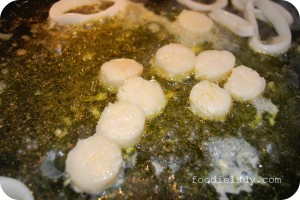
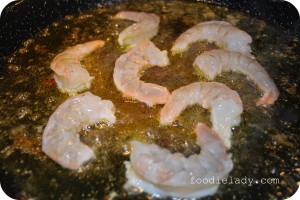
3. Heat extra-virgin olive oil (medium). Add scallops (dry them with a paper towel first) and calamari rings and briefly sauté, browning scallops a little on each side. Remove from pan and set side. Add langoustines/prawns and sauté for a couple of minutes. Remove from pan. Set aside.
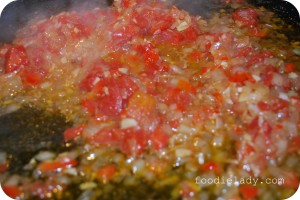
4. Add onions, garlic, fresh red bell peppers and sauté until translucent. Add grated tomatoes and tomato paste and continue to sauté to make sofrito. Mix warm white wine with saffron threads and Sweet Smoked Spanish Paprika and set aside.
5. Meanwhile, add rice and sauté with sofrito. Add wine mixture and stir. Add broth and salt and bring to a simmer. Once it begins to boil, add mussels, scallops, calamari, langoustines/ prawns by placing them on top. Place in the oven uncovered for 20 minutes. Don’t forget to place the rack at the lowest level near the heat.
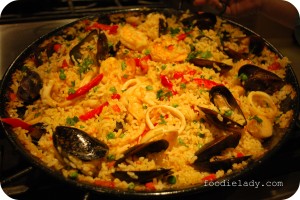
6. Open oven and sprinkle with frozen sweet green peas and cook for 5-10 more minutes until all liquid is absorbed.
7. Remove from oven and garnish with fresh parsley and strips of pimiento morrón and lemon wedges. Cover with aluminum foil paper for the resting period, 10-15 minutes. Serves 6-8 persons.










Well…I’ll be in Spain shortly & certainly will be thinking of you & your knowledge when I try the authentic arroz a la paella….then, when I arrive, I’ll be sure to tell you which was better! Hope I win, since the best intention will get me no where without my paellera!
thanks fifi! have fun on your trip to “la madre patria!” buena suerte!
Loved your post! Great information on “the true” paella. The only paella I have ever known is the one you get in PR. Yours look absolutely mouthwatering. I am looking forward to making this recipe during the summer, thanks!
I LOVE paella! …and I would love to win this giveaway.
Your blog always makes me hungry – the pictures are savory!! The stories are so inspiring. Thanks for sharing… one of these days soon, I will try many of these recipes!!! xox
Aleidita: Excellent job. For some reason in Puerto Rico people believe that making an “arroz Guisao” with saffron instead of Annato makes it a Paella, and of course lets not forget the idiot proof “Uncle Bens”. Maybe this will inspire people to try and make the real thing. I have found short grain rice works well to create the desired consistency.
Kako
kako: creating this post was a lot of fun. when i make paella for friends and family at home people always ask why mine was different. of course it is the rice. everyone is used to the parboiled kind!!! ja! thanks for your tips, you have the experience and professional background which is reassuring.
I would substitute shrimp for the mussels
I have always wanted to try my hand at a true Paella. I think it is a wonderful dish that just brings family and friends together. Yours looks amazing!
Thanks so much for the opportunity to enter my name.
Making paella seems like a daunting task but your thorough instructions definitely demystify it. And what’s rice without a little pegao? Thanks for the recipe and the inspiration.
thanks adriana! took a look at your blog and its very nice. lovely pictures and stories. keep up your foodieventurous spirit!!!!! and visit me again soon!
Aleidita!
He tratado de que Antonio se entusiasme y se compre un Paella Pan …pero No se entusiasma…! Si me gano esta, no le quedara remedio!
Aleidita!
Te felicito por Foodie Lady! Me encanta leer tus recetas y espero este verano tener mas tiempo para hacer mas de ellas!
Un abrazo, Lilly
lilly: gracias! good luck!
Ive never has a paella that i really liked, im sure your recipe will be the best – i want to try it right away – thanks for the great work you do for all of us – by the way, we still have picadillo several times per month, still cry of happiness everytime i eat it – all thanks to you!!!!
alex: its so wonderful and satisfying to hear comments like yours. i made picadillo last night to make lasagna. its so flavorful and versatile. good luck with the paella!
Great post! I’ve looked at so many recipes in the past months…have tried making the paella twice already, but I’ve failed to get a loose grain. The flavor is right on the spot, but the rice comes out kinda mushy..I’ve used medium grain rice. Maybe next time I’ll follow your oven trick.
monica: when using medium grain, i would add a little less liquid. maybe 3/4 of a cup less. but try it with bomba rice which is superb! good luck!
Thursday I cooked a paella valenciana and I used Uncle Bens rice because I dont like the paella if it is amogolla, and it turned out beautiful. I cooked the whole 3 pounds and a cup and 1/2 half additional and
I cooked a paella valenciana on thursday anI d it turned out beautiful with Uncle Ben rice. I use this rice because I don’t like the arroz amogollao.I cooked the whole 3 pounds and a lot of chicken, meat and seafood. I also used sazon with azafran Goya and homemade chicken broth/
hi sonia! i’m sure your version was delicious. next time give this technique a try following all the steps and the chances are high your next paella will not get “amogollá” with arroz bomba. if using medium grain rice, add a little less liquid. good luck and thanks for your comments. hope you visit me again soon!
Hola, Aleidita. Hace días que no escribo en mi blog ni leo nada. El sábado pasado fue la boda de mi hija menor, Patricia, aquí en casa y cociné todo menos el bizcocho. O sea, que he estado super ocupada los últimos 2 meses pero muy feliz. Todo quedó super y la semana que viene pienso poner todo el mi blog desde que me enteré que se querían casar aquí en casa. Habían cerca de 100 personas.
Siempre he querido aprender a hacer paella… Gracias porque voy a ver si este fin de semana mismo la voy a probar.
Muchos cariños.
asela: ya te extrañaba. entre a tu blog hace unas semanas y no vi nada nuevo y me imagine que en algo estabas. felicidades! let me know how it goes with this one!!!!
i WOULD LOVE TO MAKE THIS PAELLA, IVE TRIED EVERY WHERE THEIR PAELLA BUT IVE NOT LIKED THEM.THEY ARE EITHER DRY, SOUPY UNCOOKED OR FISHY,THIS ONE LOOKS AWSOME,IM GOING TO TRY TO FIND THE INGRIDIENST,AND WOULD LET YOU KNOW HOW IT COMES OUT,THANKS MARIA
Aleidita,
Voy a ver cuando la hago y te cuento!!
Cariños,
Maria Luisa